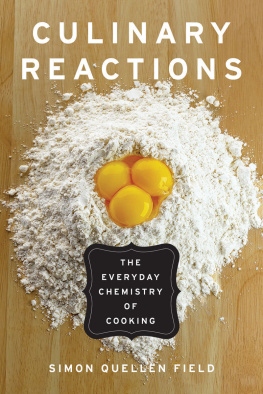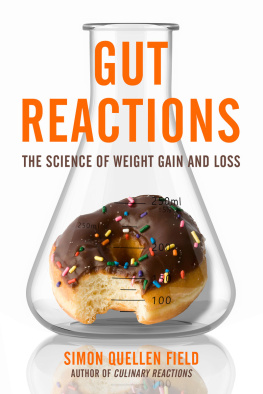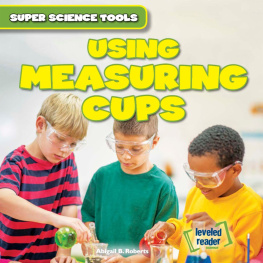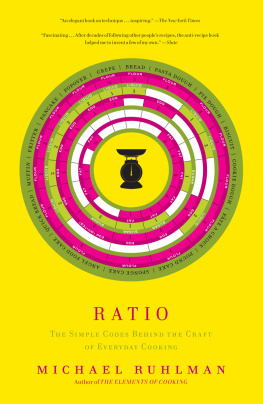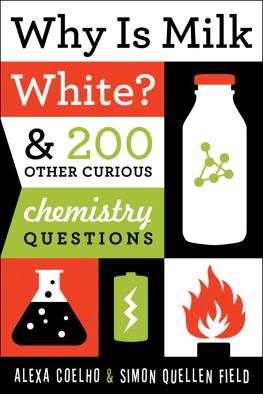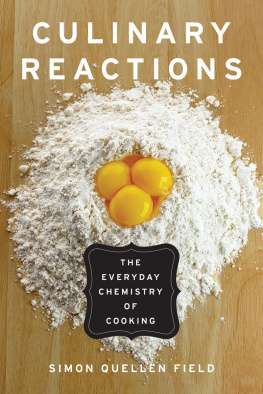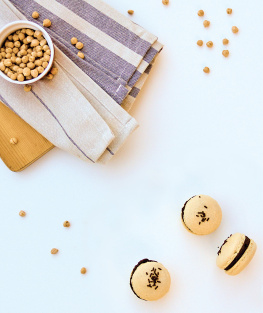

Library of Congress Cataloging-in-Publication Data
Field, Simon (Simon Quellen)
Culinary reactions : the everyday chemistry of cooking / Simon Quellen Field.
p. cm.
Includes index.
Summary: When youre cooking, youre a chemist! Every time you follow or modify a recipe, you are experimenting with acids and bases, emulsions and suspensions, gels and foams. In your kitchen you denature proteins, crystallize compounds, react enzymes with substrates, and nurture desired microbial life while suppressing harmful microbes. And unlike in a laboratory, you can eat your experiments to verify your hypotheses. In CULINARY REACTIONS, author Simon Field explores the chemistry behind the recipes you follow every day. How does altering the ratio of flour, sugar, yeast, salt, butter, and water affect how high bread rises? Why is whipped cream made with nitrous oxide rather than the more common carbon dioxide? And why does Hollandaise sauce call for clarified butter? This easy-to-follow primer even includes recipes to demonstrate the concepts being discussed, including Whipped Creamsicle Topping (a foam), Cherry Dream Cheese (a protein gel), and Lemonade with Chameleon Eggs (an acid indicator). It even shows you how to extract DNA from a Halloween pumpkin. Youll never look at your graduated cylinders, Bunsen burners, and beakerser, measuring cups, stovetop burners, and mixing bowlsthe same way againProvided by publisher.
ISBN 978-1-56976-706-1 (pbk.)
1. FoodAnalysis. 2. Cooking. I. Title.
TX545.F46 2012
664.07dc23
2011029366
Cover design: John Yates at Stealworks.com
Cover photograph: Sabine Scheckel/Photodisc/Getty Images
Interior design: Scott Rattray
2012 by Simon Quellen Field
All rights reserved
Published by Chicago Review Press, Incorporated
814 North Franklin Street
Chicago, Illinois 60610
ISBN 978-1-56976-706-1
Printed in the United States of America
5 4 3 2 1
To Kathleen, my favorite chef
CONTENTS
INTRODUCTION
Y our mother was a chemist. In the kitchen, she experimented with acids and bases, emulsions, suspensions, gels, and foams. She denatured proteins, crystallized compounds, reacted enzymes with substrates, and nurtured desired microbial life while suppressing harmful microbes. In other words, she cooked your dinner.
Cooking is often about combining ingredients to create something completely different. It involves many chemical and physical changes to the food that the cook carefully controls in order to produce the desired result. This book is about those changes. Understanding them might help make you a better cook, but my aim here is mostly to have fun.
You can learn a lot of science in the kitchen. But just looking at food in a different way can be fun and enlightening. How many of your favorite foods are foams? Bread, cake, whipped cream, marshmallows, ice cream, and meringueall would be quite different if they didnt have bubbles of gas in them. What makes some foods foam and others not? What happens when you heat a foam? What is actually going on in the bread that changes it from a sticky, runny dough or batter into a structural element that holds a sandwich together?
Knowing how things work also helps when you want to make changes to a recipe. What would you have to do if you wanted a harder cookie, or a softer one? What went wrong when you tried to make fudge but got a hard lump of rock in the pan instead? If you dont want to use an ingredient thats less than healthy or that you are allergic to, what should you replace it with? What other changes will you have to make?
A L ITTLE W HILE B ACK I made a big batch of ice cream for a group of Nobel Prize winners and other brilliant scientists at a scientific convention. I brought along a huge 160-liter Dewar flask of liquid nitrogen, and we made ice cream. At -321F (-196C), the liquid quickly cooled the ingredients to the right temperature. But at the same time, the nitrogen boiled vigorously, making a foam of nitrogen gas (basically air without the oxygen) to whip up the ice cream. Instead of a rock-hard chunk of ice, we got something closer to soft-servewonderfully smooth, the ice crystals so tiny the tongue mistook them for cream.
It is in that spirit that these pages will continue. Lets have fun. Lets play with our food.
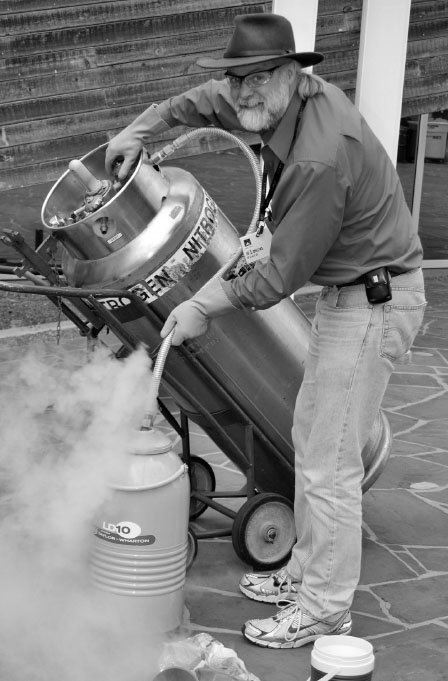
MEASURING AND WEIGHING
I n science, and especially in chemistry, careful weighing and measuring are important for reproducible results. If someone cannot reproduce your results, there is little point in doing the experiment.
For people to reproduce a culinary masterpiece, it is important to carefully weigh and measure according to a recipe. But when youre just cooking up some breakfast, it is more important to know why the ingredients are used, and why certain processes are followed. With this knowledge, you create and adjust the food on the fly, substituting some ingredients you have for some you dont, or use up things from the back of the refrigerator before they go bad.
Variations in Recipes
You can get a feel for how important measuring is by comparing recipes. Suppose you look at 10 recipes for homemade cupcakes and compare the ratios of flour and sugar in them:
| Flour | Sugar | Ratio |
| 1.5 | 1 | 150.00% |
| 2.75 | 1.5 | 183.33% |
| 2 | 1.5 | 133.33% |
| 1.5 | 1 | 150.00% |
| 2 | 2 | 100.00% |
| 3 | 2 | 150.00% |
| 2 | 2 | 100.00% |
| 2.5 | 1 | 250.00% |
| 3 | 2 | 150.00% |
| 2.5 | 2 | 125.00% |
| Mean | 149.17% |
| Standard Deviation | 43.47% |
The average cupcake has one and a half times as much flour as sugar. But some cupcakes have equal amounts, and some have two and a half times as much flour as sugar. The high standard deviation means that there is a lot of variation among simple cupcake recipes. A good cook can feel free to vary the amount of sugar in the recipe for taste or to compensate for what will accompany the cake, such as icing or bits of fruit in the batter.
Why Sifted Flour?
Some recipes list the ingredients by weight instead of volume. Some cooks swear by weighing everything, to get consistent results. When consistency of results is important, by all means, measure carefully. But when a little variation and creativity are called for, or when you are changing parts of the recipe for whatever reason, judgment and knowledge are more important.
Recipes once called for sifting flour. Flour was something that often had lumps, bits of millstone, or insects in it, so sifting was important. Other reasons have been suggested for sifting, such as aeration, or mixing dry ingredients, but a whisk in a bowl can accomplish both these tasks. The bother of sifting would not be worth it if either of these were the main reason.
Next page
